Lidl SWOT Analysis: Free PPT Template and In-Depth Insights
Discover Lidl's strengths, weaknesses, opportunities, and threats with our free PowerPoint template. This in-depth SWOT analysis provides valuable insights to help you understand Lidl's market position and strategic direction.
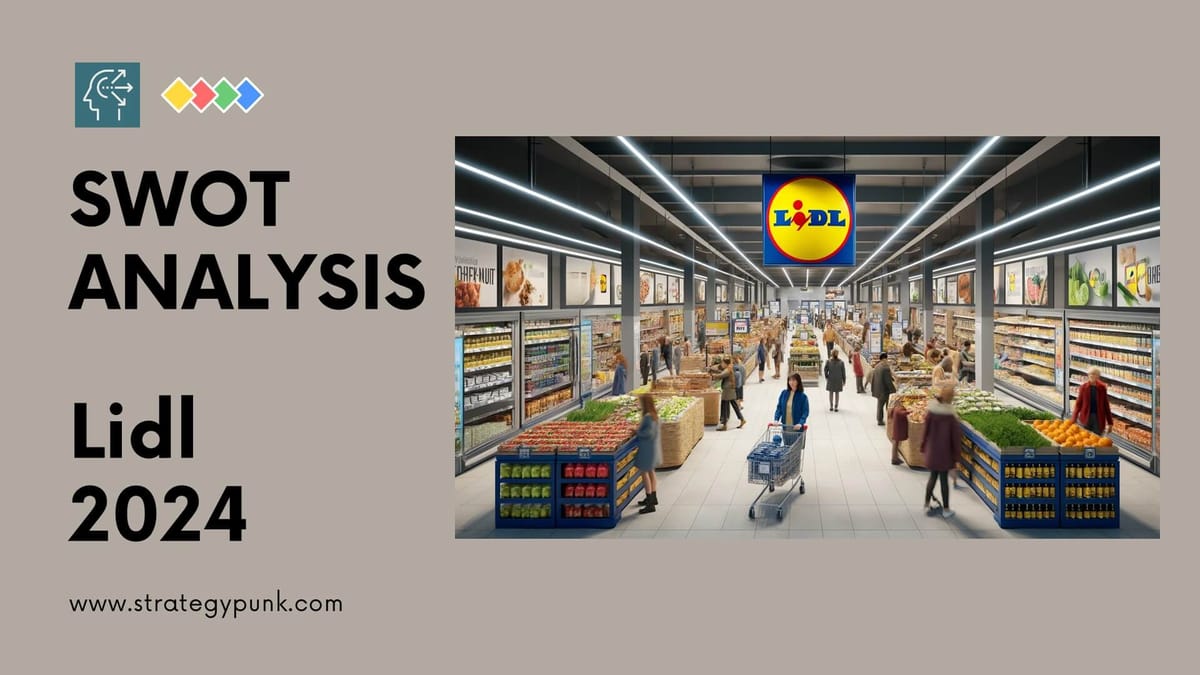
Introduction
Imagine a bustling supermarket where every aisle brims with unbeatable deals.
This is the world of Lidl, a retail phenomenon sweeping across Europe and beyond where shoppers can fill their carts without emptying their wallets.
Lidl's awe-inspiring journey from a local German grocer to a global powerhouse is a testament to strategic brilliance and unwavering commitment to value. As consumers tighten their belts, Lidl's allure grows stronger, offering a lifeline in an era of soaring inflation.
But what lies beneath Lidl's success? What forces propel this juggernaut forward, and what challenges lurk on the horizon?
A SWOT analysis provides a comprehensive lens to dissect Lidl's strengths, weaknesses, opportunities, and threats, unveiling the inner workings of this retail titan.
A Brief Look at the History of Lidl
Lidl's origins date back to the 1930s, when Josef Schwarz opened a grocery wholesaler in Neckarsulm, Germany. His son, Dieter Schwarz, revolutionized the family business in the 1970s by introducing the discount supermarket concept.
The first Lidl store opened in 1973, offering a streamlined selection of high-quality products at rock-bottom prices. This lean, no-frills approach resonated with cost-conscious consumers, fueling Lidl's rapid expansion across Germany and eventually into neighboring European countries. Lidl's success can be attributed to its ability to understand and cater to its customer base's needs and preferences, primarily value-conscious shoppers prioritizing affordability and quality.
Today, Lidl boasts over 11,000 stores in 32 countries and employs over 300,000 people worldwide. Its relentless pursuit of efficiency and value has disrupted the grocery landscape, challenging established giants and redefining consumer expectations.
What is the business model of Lidl?
Lidl's business model revolves around a simple yet powerful premise: offer a curated selection of high-quality products at the lowest possible prices.
Several key pillars underpin this strategy:
- Private Label Focus: Lidl primarily stocks its shelves with private-label goods, which allows it to control costs and quality more effectively.
- Streamlined Operations: Lidl's stores are designed for maximum efficiency, with a limited product range and minimal staffing, reducing overhead expenses.
- Strategic Sourcing: Lidl leverages its immense buying power to negotiate favorable terms with suppliers, passing on savings to customers.
- Vertical Integration: Lidl owns and operates bakeries, meat processing facilities, and distribution centers, further optimizing costs and quality control.
This disruptive, vertically integrated approach enables Lidl to offer rock-bottom prices without compromising quality, a winning formula that has disrupted the grocery industry and won over legions of loyal customers.
In-depth SWOT Analysis of Lidl 2024
A meticulous SWOT analysis, evaluating the company's internal strengths and weaknesses and external opportunities and threats, is essential to comprehensively understanding Lidl's strategic position.
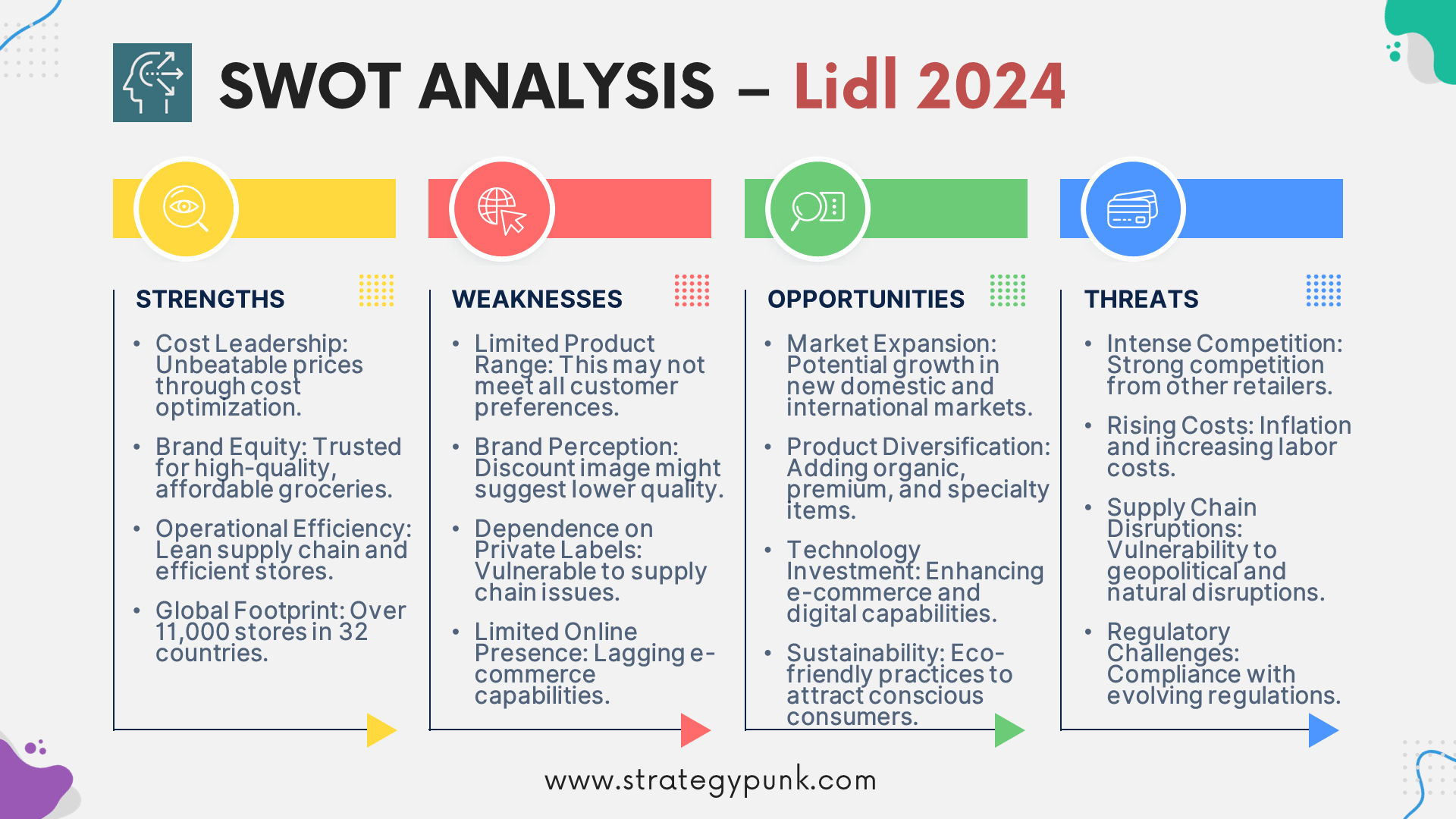
Lidl's Strengths
- Cost Leadership: Lidl's unwavering commitment to cost optimization, from streamlined operations to strategic sourcing, enables it to offer unbeatable prices to consumers.
- Brand Equity: Lidl has cultivated a strong brand identity as a purveyor of high-quality, affordable groceries, fostering customer loyalty and trust.
- Operational Efficiency: Lidl's lean, vertically integrated supply chain and minimalist store formats contribute to industry-leading operational efficiency and cost savings.
- Global Footprint: With over 11,000 stores across 32 countries, Lidl boasts a formidable global presence, enabling economies of scale and diversification.
Lidl's Weaknesses
- Limited Product Range: While cost-effective, Lidl's streamlined product selection may not appeal to customers seeking a wider variety of choices.
- Brand Perception: Lidl's discount positioning may indicate lower quality in some markets, hindering its appeal to specific consumer segments.
- Dependence on Private Labels: Lidl's heavy reliance on private-label products could make it vulnerable to supply chain disruptions or quality issues.
- Limited Online Presence: Lidl's e-commerce capabilities must catch up to competitors, potentially hampering its ability to capitalize on the growing online grocery market.
Lidl's Opportunities
- Expansion into New Markets: With a proven business model and strong financial backing, Lidl has ample opportunities to expand into untapped markets domestically and internationally. Lidl's expansion strategy is focused on markets with high growth potential and a large population of value-conscious consumers, such as the United States and China.
- Diversification of Product Offerings: Introducing a broader range of products, including organic, premium, and specialty items, could attract new customer segments and increase basket sizes.
- Leveraging Technology: Investing in digital capabilities, such as e-commerce platforms, mobile apps, and data analytics, could enhance the customer experience and drive operational efficiencies.
- Sustainability Initiatives: Embracing sustainable practices, such as reducing food waste, promoting eco-friendly packaging, and sourcing from local suppliers, could resonate with environmentally conscious consumers.
Lidl's Threats
- Intense Competition: Lidl faces stiff competition from established grocery chains and emerging discount retailers, vying for market share in an increasingly crowded landscape. This competition poses a significant challenge to Lidl's growth and market dominance, requiring the company to continually innovate and differentiate itself from its rivals.
- Rising Costs: Inflationary pressures, fluctuating commodity prices, and increasing labor costs could erode Lidl's cost advantages and squeeze profit margins.
- Supply Chain Disruptions: Lidl's lean supply chain, while efficient, could be vulnerable to disruptions caused by geopolitical tensions, natural disasters, or other unforeseen events.
- Regulatory Challenges: Evolving labor practices, environmental standards, and food safety regulations could pose compliance challenges and increase operational costs.
Lidl SWOT Analysis Summary
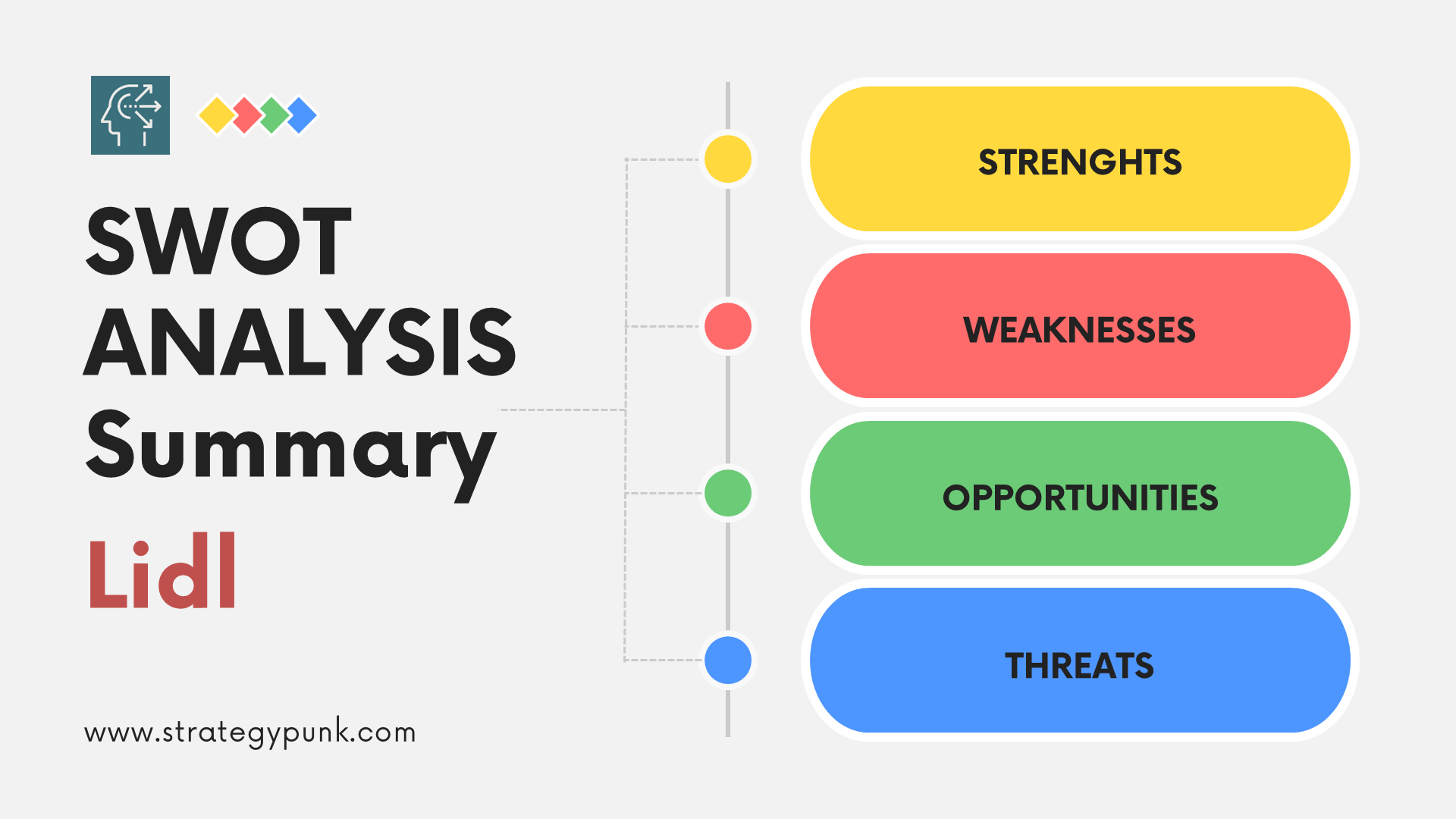
Internal Factors
Lidl's internal strengths, including its cost leadership, operational efficiency, and global footprint, have driven its success. However, to maintain its competitive edge, the company must address its limited product range, brand perception challenges, and dependence on private labels.
External Factors
Externally, Lidl faces both opportunities and threats. Expansion into new markets, diversification of product offerings, and leveraging technology present avenues for growth. Conversely, intense competition, rising costs, supply chain disruptions, and regulatory challenges could impede Lidl's progress.
Lidl's strategies for success
To capitalize on its strengths, mitigate weaknesses, seize opportunities, and navigate threats, Lidl must adopt a multi-pronged strategic approach:
- Enhance Digital Capabilities: Investing in e-commerce platforms, mobile apps, and data analytics will enable Lidl to tap into the growing online grocery market and enhance the customer experience.
- Expand Product Assortment: Introducing a broader range of products, including organic, premium, and specialty items, could attract new customer segments and increase basket sizes while focusing on value.
- Embrace Sustainability: Implementing sustainable practices, such as reducing food waste, promoting eco-friendly packaging, and sourcing from local suppliers, could resonate with environmentally conscious consumers and differentiate Lidl from competitors. This commitment to sustainability could enhance Lidl's brand image, foster customer loyalty, and attract a new segment of environmentally conscious consumers, thereby driving long-term growth and profitability.
- Optimize Supply Chain: Continuously refining Lidl's supply chain operations through technology, strategic partnerships, and supplier diversification can mitigate disruption risks and maintain cost advantages.
- Targeted Market Expansion: Carefully evaluating and entering new markets domestically and internationally can fuel Lidl's growth while leveraging its proven business model and operational expertise.
By executing these strategies effectively, Lidl can fortify its position as a leading discount retailer, capitalize on emerging opportunities, and navigate the ever-evolving competitive landscape.
Frequently Asked Questions
What is Lidl's primary competitive advantage?
Lidl's primary competitive advantage lies in its cost leadership strategy, which is enabled by streamlined operations, strategic sourcing, and a focus on private-label products. This strategy allows Lidl to offer unbeatable prices to consumers.
How does Lidl maintain quality while keeping prices low?
Lidl maintains quality through vertical integration, owning and operating its production facilities, and leveraging its immense buying power to negotiate favorable terms with suppliers. This ensures high standards at low costs.
What challenges does Lidl face in expanding into new markets?
Lidl may face challenges adapting its business model to local consumer preferences, navigating regulatory environments, and overcoming brand perception hurdles in new markets, requiring localized strategies and marketing efforts.
How is Lidl addressing the growing demand for online grocery shopping?
While Lidl has lagged in e-commerce capabilities, the company invests in digital platforms, mobile apps, and delivery services to tap into the growing online grocery market and meet evolving consumer expectations.
What role does sustainability play in Lidl's strategy?
Sustainability is becoming an increasingly important focus for Lidl. Initiatives such as reducing food waste, promoting eco-friendly packaging, and sourcing from local suppliers resonate with environmentally conscious consumers and differentiate the brand.
Lidl SWOT Analysis PowerPoint Template
free and fully editable PPT template
A SWOT analysis evaluates the strengths, weaknesses, opportunities, and threats impacting a company.
This free editable PowerPoint template provides a SWOT analysis framework to evaluate Lidl's internal strengths and weaknesses and external opportunities and threats.

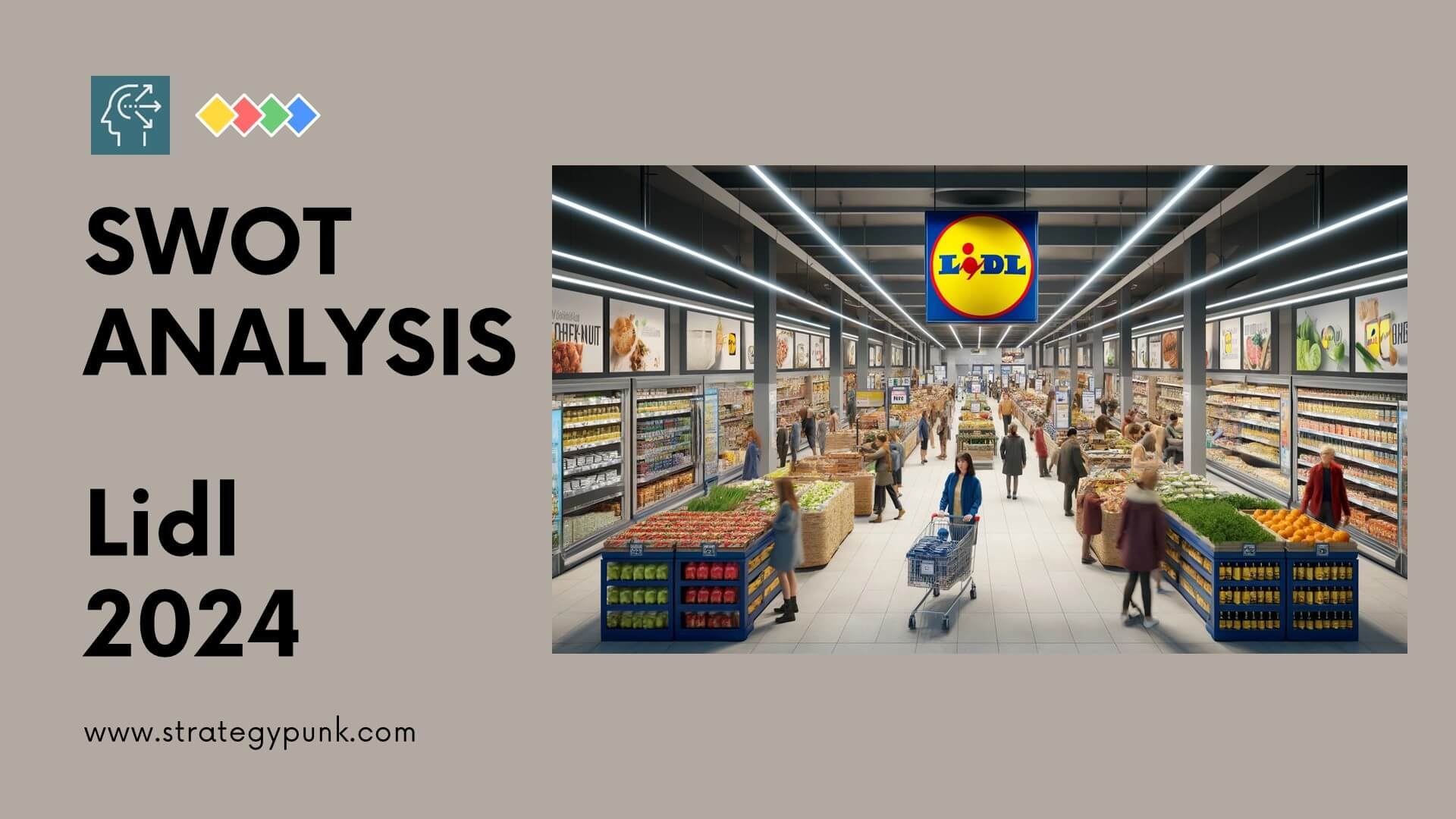
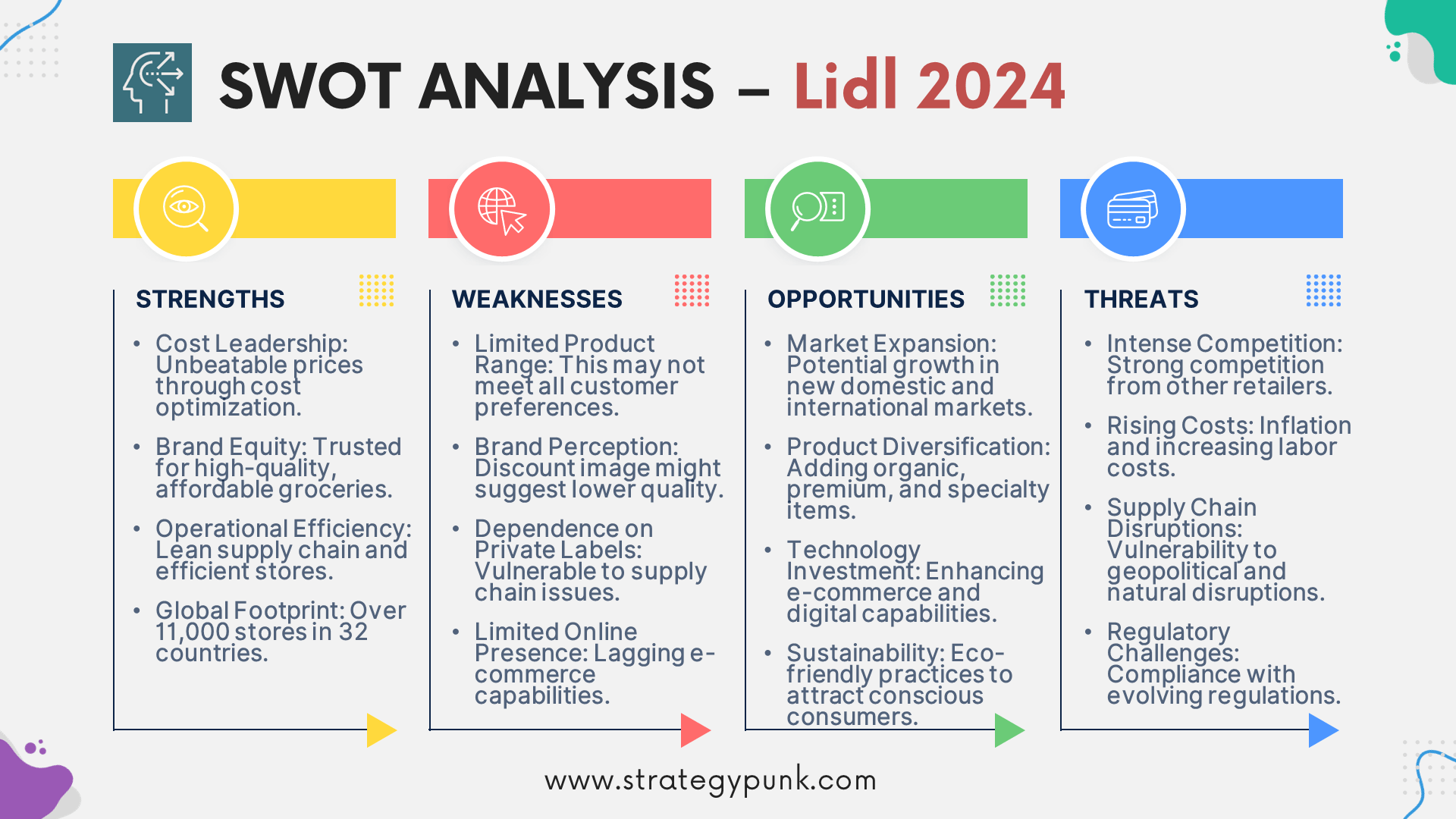
Lidl SWOT Analysis 2024 PowerPoint Template
Lidl SWOT Analysis 2024 PDF Template
Discover more
Clickworthy Resources
SWOT Analysis: Free PowerPoint Template
This PowerPoint slide deck contains five different layouts to complete a SWOT analysis.
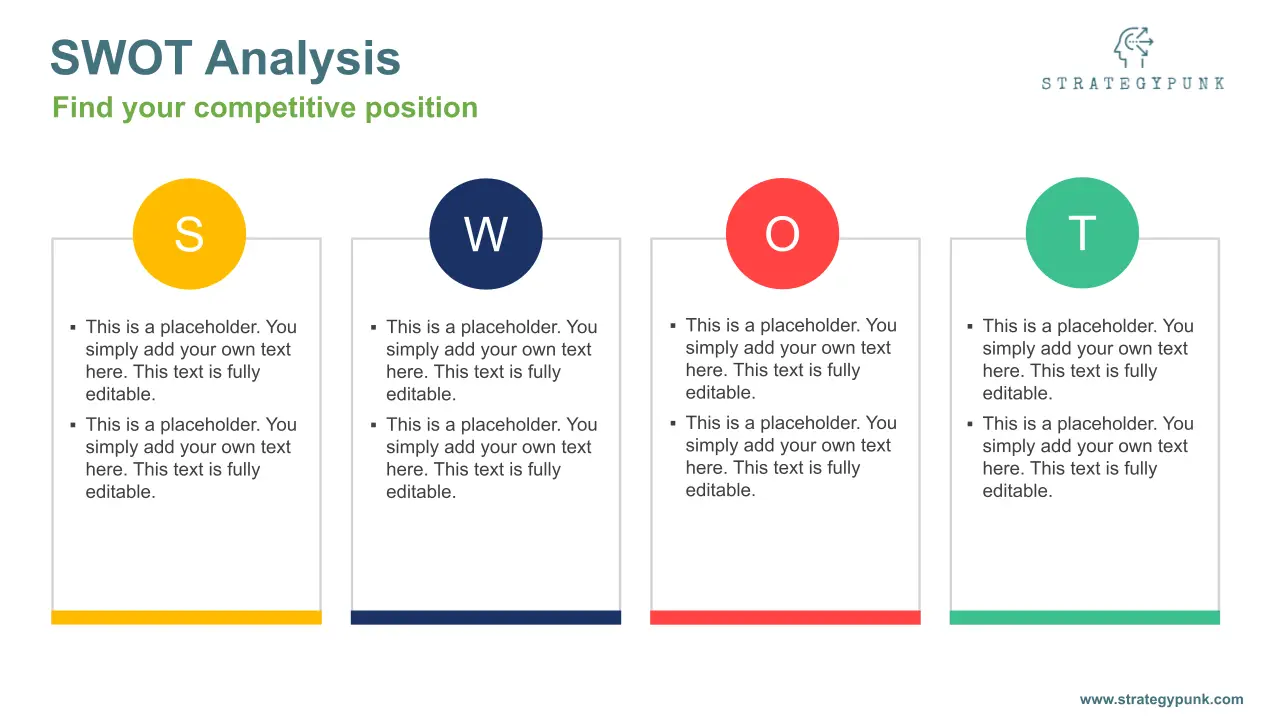
New! SWOT Framework & Free PPT Template - 2024 Edition
Dive into the 2024 Edition of our SWOT Analysis guide, complete with a free PowerPoint template. This resource covers the essentials of conducting a SWOT analysis, its benefits, and practical application tips, including a case study on Mercedes Benz.
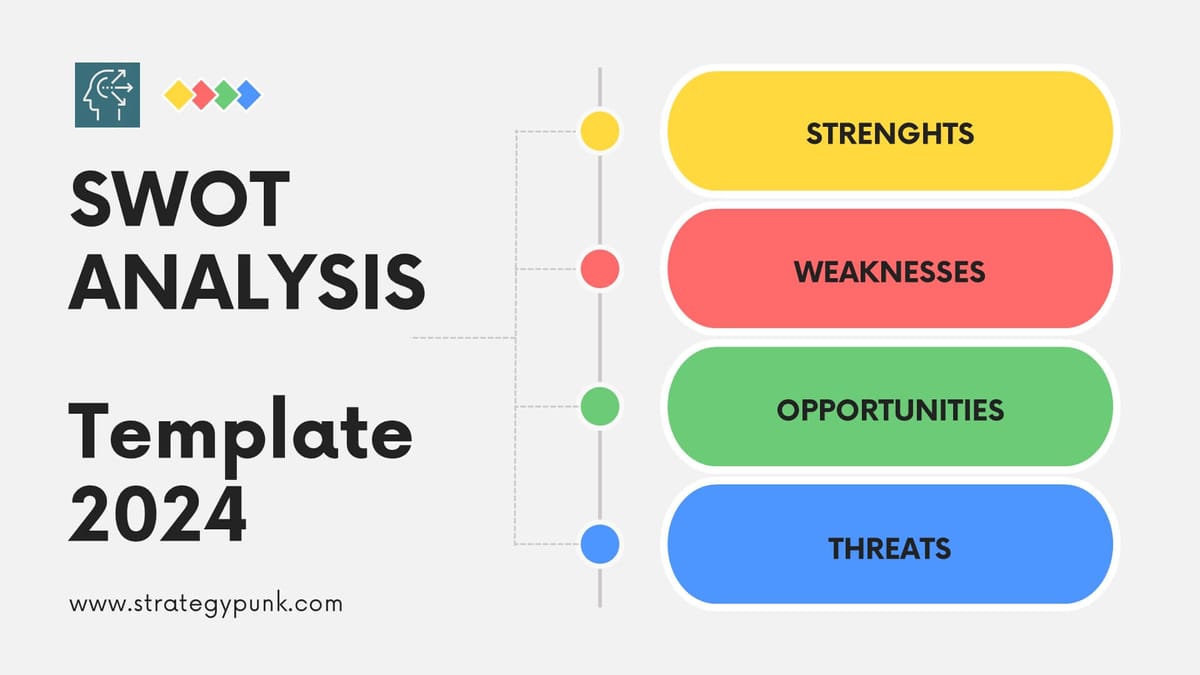
Primark SWOT Analysis: Free PPT Template and In-Depth Insights 2024
Explore Primark's 2024 SWOT Analysis with our free PowerPoint template. Gain critical insights into strengths, weaknesses, opportunities, and threats. Download now for a comprehensive analysis.







